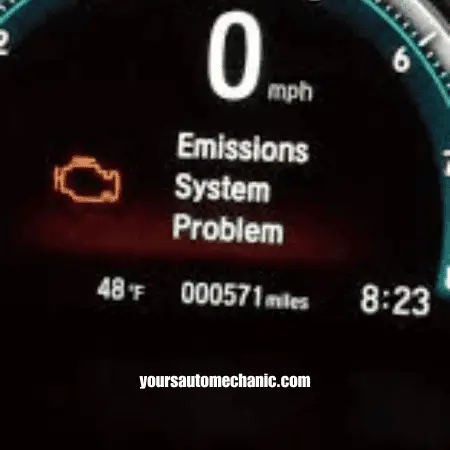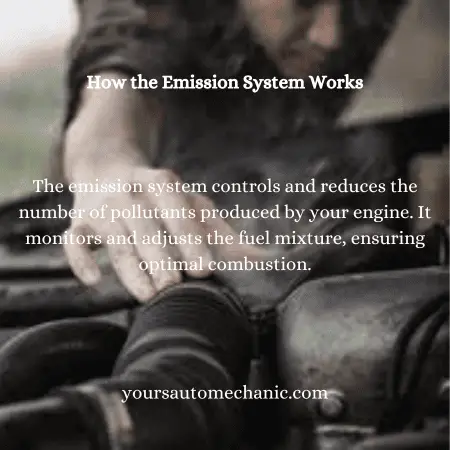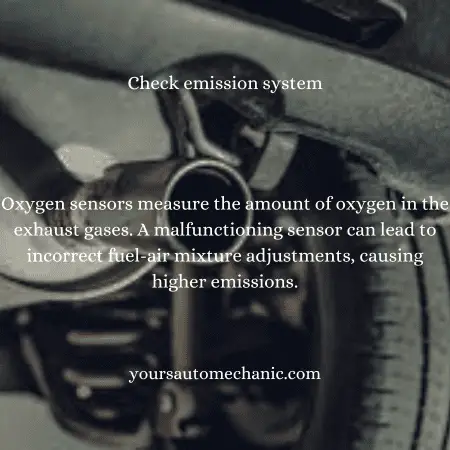Your car’s emission system is crucial for keeping the environment clean and your vehicle running smoothly. Therefore, maintaining your car’s emission system is essential. Sometimes, for various reasons, the check emission system light may blink on your car’s dashboard. Let’s dive into what this system is and how you can maintain it. So keep on reading…
What Is An Emission System
The emission system in a car is a collection of components designed to reduce the harmful pollutants produced by the engine. Key parts of this system include the catalytic converter, which converts toxic gases into less harmful substances, and the oxygen sensor, which helps regulate the engine’s fuel efficiency. By working together, these components help minimize the environmental and health impacts of vehicle emissions.

Symptoms of Emission System Issues
Check Engine Light: One of the most common signs of an emission system problem is the check engine light turning on. This light can indicate a variety of issues, many of which are related to the emission system.
Decreased Fuel Efficiency: If your car is using more fuel than usual, it could be due to a problem in the emission system, such as a faulty oxygen sensor or a malfunctioning catalytic converter.
Poor Engine Performance: Issues like rough idling, stalling, or difficulty starting can indicate problems with components of the emission system.
Unusual Exhaust Smell: A strong smell of gasoline, sulfur (rotten eggs), or other unusual odors coming from the exhaust can signal a problem with the emission system.
Increased Exhaust Smoke: Excessive or colored smoke from the exhaust, such as black, blue, or white smoke, can be a sign that the emission system is not working properly.
Failed Emissions Test: If your car fails an emissions test, it’s a clear indication that there’s a problem with the emission system that needs to be addressed.
Engine Misfires: Frequent engine misfires can result from issues within the emission system, such as problems with the EGR valve or spark plugs.
Loud Noises: Unusual noises from the exhaust system, such as hissing, popping, or loud rumbling, can indicate a leak or a problem with the catalytic converter.
Must Read
- What Is Speed Compensated Volume? Benefits & Limitations
- Can You Drive Without a Muffler? Pros & Cons Of Removing Mufflers
- How To Pass Emissions With A Deleted Diesel – A complete Guide

Common Emission System Problems
Faulty Oxygen Sensor: A malfunctioning oxygen sensor can lead to poor fuel efficiency and increased emissions. This sensor measures the amount of oxygen in the exhaust and helps adjust the air-fuel mixture.
Catalytic Converter Issues: If the catalytic converter gets clogged or damaged, it can’t effectively convert harmful gases into less harmful ones. This can result in a decrease in engine performance and an increase in emissions.
Exhaust Leaks: Leaks in the exhaust system can cause unfiltered exhaust gases to escape before they reach the catalytic converter. This increases pollution and can be dangerous to vehicle occupants due to potential exposure to carbon monoxide.
Malfunctioning EGR Valve: The Exhaust Gas Recirculation (EGR) valve helps reduce nitrogen oxide emissions by recirculating some exhaust gases back into the engine. If the EGR valve fails, it can lead to higher emissions and engine knocking.
Damaged or Worn-Out Spark Plugs: Spark plugs ignite the fuel-air mixture in the engine. If they are damaged or worn out, incomplete combustion can occur, leading to higher emissions and reduced fuel efficiency.
Evaporative Emission Control (EVAP) System Problems: The EVAP system prevents fuel vapors from escaping into the atmosphere. Issues with this system, such as a faulty gas cap or a leak, can lead to increased emissions and trigger the check engine light.
Clogged Air Filter: A dirty or clogged air filter can restrict airflow to the engine, causing it to run rich (too much fuel). This can increase emissions and decrease fuel economy.
Mass Air Flow (MAF) Sensor Failure: The MAF sensor measures the amount of air entering the engine. If it fails, the engine may run inefficiently, leading to higher emissions and poor performance.

how to check the emission system
To check the emission system of a vehicle, there are several steps you can follow, ranging from visual inspections to using diagnostic tools. Here’s a comprehensive guide:
1. Visual Inspection
Exhaust System: Check for visible damage or leaks in the exhaust system components, including the muffler, catalytic converter, and exhaust pipes.
Hoses and Connections: Inspect vacuum hoses and connections for cracks, disconnections, or wear.
2. Dashboard Warning Lights
Check Engine Light: If the check engine light is on, use an OBD-II scanner to retrieve the diagnostic trouble codes (DTCs). These codes can point you to specific issues within the emission system.
3. OBD-II Scanner
- Scan for Codes: Connect an OBD-II scanner to the vehicle’s diagnostic port (usually located under the dashboard). Read the codes and note any related to the emission system (e.g., P0420 for catalytic converter efficiency).
- Live Data: Use the scanner to view live data from sensors related to the emission system, such as oxygen sensors, MAF (Mass Air Flow) sensor, and EGR (Exhaust Gas Recirculation) system.
4. Emission Components
Oxygen Sensors: Check the operation of upstream and downstream O2 sensors. These sensors monitor the amount of oxygen in the exhaust and are critical for maintaining proper air-fuel ratio.
Catalytic Converter: Ensure the catalytic converter is functioning correctly. If it’s clogged or damaged, it can lead to increased emissions and poor performance.
EGR System: Inspect the EGR valve and associated components. The EGR system reduces nitrogen oxide emissions by recirculating a portion of the exhaust gases back into the engine cylinders.
PCV Valve: Check the Positive Crankcase Ventilation valve, which helps reduce emissions by rerouting blow-by gases from the crankcase back into the intake manifold.
5. Fuel System
Fuel Cap: Ensure the fuel cap is properly sealed. A loose or damaged fuel cap can cause evaporative emission leaks.
EVAP System: Inspect the Evaporative Emission Control (EVAP) system, which prevents fuel vapors from escaping into the atmosphere. Check for leaks or faults in the EVAP system components.
6. Smoke Test
If you suspect a vacuum leak or an issue with the EVAP system, consider performing a smoke test. A smoke machine introduces smoke into the system, allowing you to visually identify leaks.
7. Professional Emission Test
Smog Check: In some regions, vehicles are required to pass a smog or emission test. This test measures the levels of various pollutants in the exhaust. If your vehicle fails the test, the report will usually indicate which components are causing excessive emissions.
How To Fix Emission System Issues
Replace the Oxygen Sensor:
Use an OBD-II scanner to determine which oxygen sensor is malfunctioning.
Buy a compatible oxygen sensor for your vehicle.
Locate the faulty sensor, usually in the exhaust system, and replace it with the new one. Follow the manufacturer’s instructions for installation.
Repair or Replace the Catalytic Converter:
Visually inspect the catalytic converter for any signs of damage or clogging.
If the converter is slightly clogged, you can try using a catalytic converter cleaner added to your fuel.
If cleaning doesn’t help, or the converter is severely damaged, replace it with a new one.
Fix Exhaust Leaks:
Inspect the exhaust system for any holes or cracks.
Use exhaust tape or a patch kit to seal minor leaks.
For larger leaks or severe damage, replace the affected section of the exhaust pipe.
Clean or Replace the EGR Valve:
Locate and carefully remove the EGR valve.
Use a carburetor cleaner to remove carbon buildup from the valve.
If cleaning doesn’t restore functionality, replace the EGR valve with a new one.
Replace Spark Plugs:
Inspect the spark plugs for wear or damage.
Buy the correct spark plugs for your vehicle.
Remove the old plugs and replace them with the new ones, ensuring they are properly gapped.
Fix EVAP System Issues:
Ensure the gas cap is tight and in good condition. Replace it if damaged.
Check for leaks in the hoses and connections. Replace any faulty components.
Use a hand-held vacuum pump to test the purge valve. Replace it if it doesn’t hold vacuum.
Replace the Air Filter:
Check if the air filter is dirty or clogged.
Replace the old air filter with a new one according to the manufacturer’s recommendations.
Replace the Mass Air Flow (MAF) Sensor:
Use a multimeter to test the MAF sensor’s electrical connections.
If the sensor is dirty, clean it with a MAF sensor cleaner.
If cleaning doesn’t help, replace the MAF sensor with a new one.
If you’re unsure about diagnosing or fixing the issue, take your car to a professional mechanic. They can perform a thorough diagnostic test and repair any complex problems.
You May Find Helpful
- 7E8 Engine Code – Symptoms | Causes | Troubleshooting
- P0008 Code But Car Runs Fine – Its Causes & Potential Action
- How Do I Fix Code C1201- Step By Step Guide
Conclusion
Regular maintenance and periodic checks of the emission system can help ensure your vehicle runs efficiently and within environmental regulations. If you encounter any issues or error codes, addressing them promptly can prevent further damage and costly repairs.
